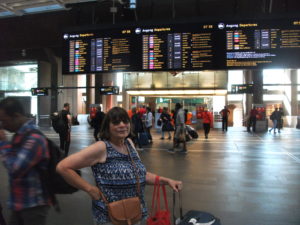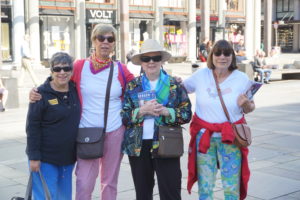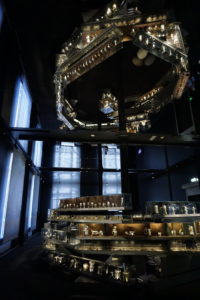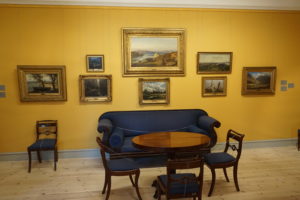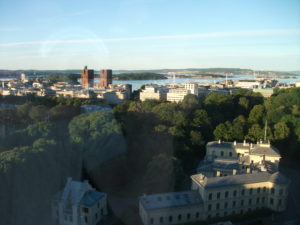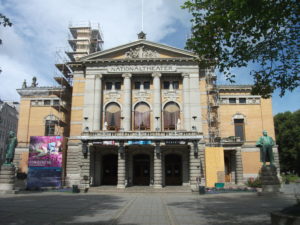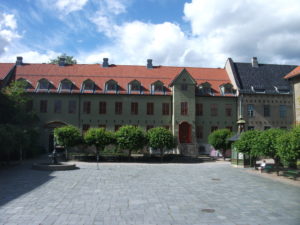For three months, I have been intermittently aware that, back in August, I shared two phases of a trip to Norway that my wife and I took in July—and that I promised to complete the story with two more. At the same time, I was laying the groundwork for an entirely new phase of my career. Having left the American Planning Association (APA) at the end of May, I was planning book projects, establishing a one-person consulting firm, preparing to teach my fall course at the University of Iowa, and undertaking periodic speaking engagements. This was all part of my “five-point retirement plan,” of which the remaining piece is this blog.
Soon enough, however, given my professional focus on planning for disasters, real life overwhelmed my intentions. Even as I was laying the groundwork for Jim Schwab Consulting LLC, my consulting operation, Hurricane Harvey was blasting the Texas coast. Harvey was soon followed by Irma in Florida, then Maria in Puerto Rico, then wildfires in California. Though I have not been involved in recovery from Irma and Maria, people in Texas solicited my attention, and later I spoke at conferences in North Carolina and Utah. I am participating in a planning group for Harvey recovery, and I have undertaken some other work as well. Before I realized it, the semester was over, the holidays were upon us, and I had utterly failed to write about the rest of the Norway venture. And I do like to inject some travelogues into this blog. All disasters and policy disquisitions and no fun can make for a dull blog. (Some readers may disagree, but my mixture of subject matter seems to have broad appeal.)
So. About four months ago, I left our story in Oslo after a busy Monday. Jean and I stayed overnight, packed our bags again, and got ready to travel to Bergen. The trip between those two cities is one I would recommend to anyone with the slightest appetite for dramatic scenery. But first we had to move from our hotel, the Radisson Blu Scandinavia, to the railway station. One truly neat feature of Oslo is the tram, which was included in our Oslo Pass, as was all other public transit including the subway system. The tram stopped right behind the hotel, and the railway station was only a few stops away. We had a pleasant early morning ride down the middle of the street, then crossed the street with our luggage and entered a very modern-looking station that would put us on our train to Bergen. It all seemed very convenient and well organized.
 The train from Oslo to Bergen, however, is more than just well organized. Norway in a Nutshell notes that the Bergen Railway is “Northern Europe’s highest-altitude railway line.” The passenger cars indicate the altitude at each stop, so you can track your progress upward as well as across the country and downward again to the sea. The highest reading I recall was 1,224 meters, roughly 4,000 feet, but a glance out the window made clear the mountains around us touched the clouds at a slightly more rarefied level.
The train from Oslo to Bergen, however, is more than just well organized. Norway in a Nutshell notes that the Bergen Railway is “Northern Europe’s highest-altitude railway line.” The passenger cars indicate the altitude at each stop, so you can track your progress upward as well as across the country and downward again to the sea. The highest reading I recall was 1,224 meters, roughly 4,000 feet, but a glance out the window made clear the mountains around us touched the clouds at a slightly more rarefied level.
Once the train departs the urban environment of Oslo, the scenery changes rapidly, passing lakes and rivers and entering the interior of Norway to reveal small lowland farms in the shadows of green, often forested hills. Over a 6 ½ hour journey, the train finds its way into numerous small communities along winding valleys and into the mountains until you begin to witness snow on the peaks, even in July, where the combination of altitude and latitude make clear that Norway is never entirely green.  Knowing the long history of this nation, one can only imagine how the challenges of traversing this landscape influenced first the Viking, then the medieval, Reformation, and even Enlightenment Norwegian mindset, and why the law of primogeniture combined with meager prospects for agricultural prosperity to send waves of young people to America in search of a better life. Of course, in modern times, Norwegians have found prosperity through other means, including energy development and a highly educated work force, but for many centuries most people endured a hardscrabble life in a relatively unyielding environment. That gorgeous landscape did not make life easy for those trying to survive by breeding livestock and growing crops. Even though we did not leave the train until we reached Bergen, one could feel the chilly air when the doors opened at small town stations, and knowing it was July made one wonder how cold it might be in January.
Knowing the long history of this nation, one can only imagine how the challenges of traversing this landscape influenced first the Viking, then the medieval, Reformation, and even Enlightenment Norwegian mindset, and why the law of primogeniture combined with meager prospects for agricultural prosperity to send waves of young people to America in search of a better life. Of course, in modern times, Norwegians have found prosperity through other means, including energy development and a highly educated work force, but for many centuries most people endured a hardscrabble life in a relatively unyielding environment. That gorgeous landscape did not make life easy for those trying to survive by breeding livestock and growing crops. Even though we did not leave the train until we reached Bergen, one could feel the chilly air when the doors opened at small town stations, and knowing it was July made one wonder how cold it might be in January.
And yet there was no question that the views were strikingly beautiful–unless you were passing through one of several tunnels beneath the mountains. We were not there in the right season to attest to this, but I have read repeatedly that winds and snow in the winter make this mountainous terrain a challenging environment in which to maintain year-round train service. The Norwegians, however, are as prepared for such challenges as anyone. They keep the train moving.
 In due course, of course, one reaches the peak of the journey, and the downhill ride begins, ending near the sea in Bergen, the second-largest city in Norway behind Oslo. Because of prior arrangements by Bill Mitchell at Conlin Travel, we were greeted upon our exit from the train by a local driver who turned out to be a retired police officer, a fact he revealed in the process of insisting that we buckle up before he took us to our hotel, about 15 minutes away along the harbor. From him, we learned that Bergen is a city of nearly 300,000 people, with half as many more living in the entire metropolitan area. As first-time visitors, we were about to learn just how much Bergen has to offer.
In due course, of course, one reaches the peak of the journey, and the downhill ride begins, ending near the sea in Bergen, the second-largest city in Norway behind Oslo. Because of prior arrangements by Bill Mitchell at Conlin Travel, we were greeted upon our exit from the train by a local driver who turned out to be a retired police officer, a fact he revealed in the process of insisting that we buckle up before he took us to our hotel, about 15 minutes away along the harbor. From him, we learned that Bergen is a city of nearly 300,000 people, with half as many more living in the entire metropolitan area. As first-time visitors, we were about to learn just how much Bergen has to offer.
 Our modest but well-appointed Clarion Hotel Admiral offered a marvelously serene waterfront setting, supported by a flotilla of sail boats, fishing boats, and larger commercial craft. Somewhere further along the coast were the large cruise ships, such as the Nordnorge, on which we would be sailing by the next evening. Bergen is largely defined by its status as a seaport on a fjord near the Atlantic Ocean, but that location makes it as scenic as any city would want to be. From a crowded waterfront, homes and other buildings seem to radiate up the slopes until they thin out and the insistent lush forest takes over. We were also lucky. We were told it had been raining for most of the month before our arrival, but that, with the emergent sunshine after some initial misty cloudiness, we had “won the weather lottery.” We were grateful for the photogenic result.
Our modest but well-appointed Clarion Hotel Admiral offered a marvelously serene waterfront setting, supported by a flotilla of sail boats, fishing boats, and larger commercial craft. Somewhere further along the coast were the large cruise ships, such as the Nordnorge, on which we would be sailing by the next evening. Bergen is largely defined by its status as a seaport on a fjord near the Atlantic Ocean, but that location makes it as scenic as any city would want to be. From a crowded waterfront, homes and other buildings seem to radiate up the slopes until they thin out and the insistent lush forest takes over. We were also lucky. We were told it had been raining for most of the month before our arrival, but that, with the emergent sunshine after some initial misty cloudiness, we had “won the weather lottery.” We were grateful for the photogenic result.
 For Jean and me, after checking in and relaxing in our room, our first order of business was to meet up with personal friends who would join us on the cruise. Two of my colleagues at APA had also retired within the last few months. Carolyn Torma, formerly
For Jean and me, after checking in and relaxing in our room, our first order of business was to meet up with personal friends who would join us on the cruise. Two of my colleagues at APA had also retired within the last few months. Carolyn Torma, formerly  education director, left at the end of November 2016 and had already been traveling on her own since then. Deene Alongi, the meetings and conferences director, retired on July 12, just a few days before our trip. She and I had met over dinner about some business matters back in January, and in discussing our plans, discovered we both intended to cruise the fjords of Norway during the summer. She and Carolyn had already been making arrangements for a cruise with Hurtigruten, a Norwegian cruise company, through Mitchell, an acquaintance of Carolyn’s cousin, Carol Wargelin. Why not join forces, we decided, and book the same cruise? Using the same travel agent allowed us to connect at the same hotel, even though our three friends were arriving separately after flying straight to Bergen, letting us visit Oslo first on our own, something I wanted to do so that Jean and I could ride the train to Bergen.
education director, left at the end of November 2016 and had already been traveling on her own since then. Deene Alongi, the meetings and conferences director, retired on July 12, just a few days before our trip. She and I had met over dinner about some business matters back in January, and in discussing our plans, discovered we both intended to cruise the fjords of Norway during the summer. She and Carolyn had already been making arrangements for a cruise with Hurtigruten, a Norwegian cruise company, through Mitchell, an acquaintance of Carolyn’s cousin, Carol Wargelin. Why not join forces, we decided, and book the same cruise? Using the same travel agent allowed us to connect at the same hotel, even though our three friends were arriving separately after flying straight to Bergen, letting us visit Oslo first on our own, something I wanted to do so that Jean and I could ride the train to Bergen.
By late afternoon, I met Deene in the lobby as she entered the hotel. Later we met Carolyn and Carol, and the five of us enjoyed dinner in Admiral’s very pleasant restaurant. Our conversation revolved around plans for the following day, for we would have until 4 p.m. to wander the city before boarding a bus to the dock to enter the cruise ship.
Although our plans evolved, Bergen made it easy to enjoy the day. We discovered the Kode museums,  which line one edge of a charmingly picturesque public park anchored by a pond with a fountain but also including a gazebo and lush lawns. Using a single pass, we visited all four museums by late afternoon, punctuated by lunch at a reasonably classy diner adjoining one of them. The museums offer five daily tours in English, in addition to Norwegian. Kode 1 offers the Singer collection, a combination of Chinese porcelain, period furniture from the 16th and 17th centuries, and classic paintings, among other art, plus a splendid display of silver and gold artifacts created in the city over the past half-millennium, and the H.M. Queen Sonja “Underway,” displaying graphic and ceramic artworks sponsored by a royal who seemed to relish the chance to sponsor sculpture and craft works.
which line one edge of a charmingly picturesque public park anchored by a pond with a fountain but also including a gazebo and lush lawns. Using a single pass, we visited all four museums by late afternoon, punctuated by lunch at a reasonably classy diner adjoining one of them. The museums offer five daily tours in English, in addition to Norwegian. Kode 1 offers the Singer collection, a combination of Chinese porcelain, period furniture from the 16th and 17th centuries, and classic paintings, among other art, plus a splendid display of silver and gold artifacts created in the city over the past half-millennium, and the H.M. Queen Sonja “Underway,” displaying graphic and ceramic artworks sponsored by a royal who seemed to relish the chance to sponsor sculpture and craft works.
Kode 2 was not then open, preparing a new exhibition that opened in October. Kode 3 featured the Rasmus Meyer collection, an assortment of Norwegian paintings from 1880-1905, which is surely the golden age, with works from landscape and other
painters like J.C. Dahl, Harriet Backer, and Theodor Kittelsen. I will not claim to be any sort of expert on the subject; in fact, I learned about some of the artists for the first time in this visit. But viewing these works up close filled me with admiration for their skills and the cultural perspectives they conveyed. There can be little doubt that Norway experienced a remarkable flowering of artistic talent in the late 19th century. And that is before we even mention the substantial display of work by Edvard Munch. The iconic The Scream, for which he is best known (and of which there are four versions), is only the beginning of Munch’s lifetime of productivity, punctuated by some tragic interludes that no doubt profoundly influenced some of his artistic idiosyncrasies. However, it would be a mistake to think that all, or even most, of his work is affected by the mental illness that ran through the family, including his father, or was dark and depressed. Indeed, there is an entire strain of cheerful nature painting within his oeuvre. Munch was clearly Norway’s artistic genius.
Finally, Kode 4 branches out beyond Norway to include numerous modern European and other artists, including Pablo Picasso, Paul Klee, Diego Rivera, and Joan Miró. But as one might expect, time ran out, and we all had to stroll back to the Admiral Hotel, retrieve our stored luggage, and await transport to the Hurtigruten dock to embark on our cruise, which will be the focus of the final installment in this series.
Jim Schwab

